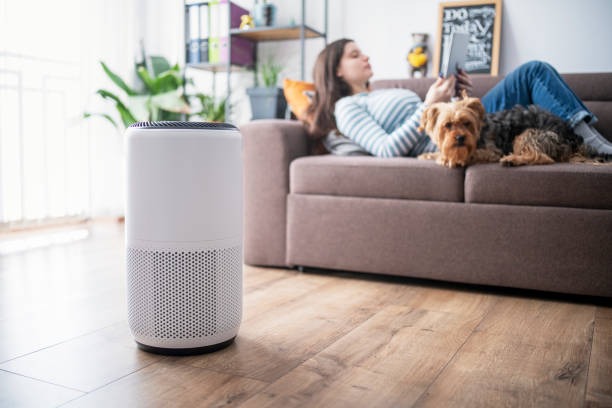
Did you know that indoor air pollution is one of the top five environmental health risks, according to the Environmental Protection Agency (EPA)? If you spend most of your time indoors, you might be exposed to various contaminants that can harm your health and well-being.
In this blog post, we will show you how to improve your indoor air quality and create a healthier and more comfortable environment for yourself and others. We will explain what indoor air quality is and why it matters, and we will explore the main factors that affect it, such as the causes of bad indoor air quality, sources of pollution, ventilation, humidity, carpets, and building materials.
By the end of this post, you will have a better understanding of how to breathe easily and stay healthy indoors.
Understanding Indoor Air Quality
Indoor air quality can have a significant impact on public health, especially for those with respiratory infections or who are young children. Proper ventilation, including the use of air conditioners, is essential for maintaining good indoor air quality and preventing sick building syndrome. Ventilation also plays a key role in reducing the risk of lung cancer, heart disease, and other health problems associated with poor air quality. Mechanical ventilation, open windows, exhaust fans, air conditioners, and energy efficiency are all important for promoting clean air and reducing the health effects of indoor air pollution.
What Constitutes Indoor Air Quality?
Indoor air quality refers to the overall quality of the air inside buildings. It encompasses both the health and comfort of the occupants. Proper ventilation systems are essential for maintaining good indoor air quality, as they help remove pollutants and ensure fresh air circulation.
Importance of Good Indoor Air Quality
Good indoor air quality is important for public health, as it can reduce the risk of respiratory diseases. This is especially important for pregnant women and older adults. Proper ventilation systems can help to maintain a healthy indoor environment and prevent health problems such as lung diseases and heart disease.
Ensuring clean air circulation indoors can also help to mitigate the health effects of poor outdoor air quality, infectious diseases, climate change impacts, and safeguard occupants from potential harm, such as wildfire smoke.
Major Causes of Bad Indoor Air Quality
Various sources of pollution can compromise indoor air quality, leading to poor ventilation and elevated humidity levels. The presence of indoor air pollutants and high levels of indoor air contaminants further deteriorate indoor air quality, contributing to health problems such as irritation of the eyes and respiratory issues. Ensuring proper ventilation, reducing indoor air pollution, and maintaining optimal humidity levels are crucial for combating bad indoor air quality and promoting a healthy indoor environment.
Sources of Indoor Air Pollution
Gas stoves, building materials, tobacco smoke, and indoor air fresheners are all potential sources of indoor air pollution. Poor ventilation systems are also a significant contributor to indoor air pollution. Radon, a known human carcinogen and a common indoor air pollutant, can have detrimental effects on human health.
Impact of Poor Ventilation
Poor indoor air quality is a direct result of inadequate ventilation, which leads to the accumulation of indoor air contaminants from various sources, both natural and man-made. This can significantly contribute to indoor air pollution and subsequently increase the risk of respiratory diseases. Ensuring proper ventilation systems is crucial for maintaining a healthy indoor environment and mitigating health problems associated with poor air quality. Adequate mechanical ventilation or simply opening windows and doors can be the most effective way to improve indoor air quality and prevent the buildup of harmful pollutants from indoor sources.
Humidity and its Role in Indoor Air Quality
Humidity levels play a crucial role in determining the quality of indoor air. High humidity levels can result in a range of indoor air quality issues due to excess moisture, leading to the presence of indoor air pollutants. Proper management and control of humidity are essential for maintaining good indoor air quality. The impact of humidity on indoor air quality cannot be overstated, making it a significant factor in ensuring a healthy indoor environment.
Carpets and Rugs: The Hidden Culprit of Poor Indoor Air Quality
Carpets and rugs can trap dust mites and release indoor air pollutants, which can contribute to poor indoor air quality. If not maintained properly, they can lead to health problems such as eye irritation and respiratory issues.
How do Carpets Affect Indoor Air Quality?
Carpets can trap contaminants, such as dust mites, and release volatile organic compounds (VOCs). Improperly maintained carpets can deteriorate indoor air quality, making regular cleaning essential for maintaining a healthy environment.
Tips to Prevent Carpet-Induced Air Pollution
-
- Regularly vacuum your carpets to reduce indoor air pollutants.
-
- Opt for low VOC carpets to improve air quality.
-
- Ensure adequate ventilation to prevent carpet-induced pollution.
-
- Keep carpets dry to avoid mold and mildew growth.
-
- Professional carpet cleaning contributes to better indoor air quality.
These measures can significantly enhance the indoor environment and mitigate health problems associated with poor air quality.
Building Materials and Indoor Air Quality
Common building materials can release volatile organic compounds (VOCs), which can impact indoor air quality. Poor ventilation can worsen this effect, and materials like paint and flooring can contribute to indoor air pollution and subsequent respiratory issues. Using proper ventilation systems is crucial in mitigating the impact of building materials on indoor air quality, ensuring a healthier indoor environment for all occupants.
Common Building Materials that Degrade Air Quality
Paints, adhesives, and carpets are common sources of indoor air pollutants, including asbestos fibers. Insulation can release harmful particulate matter, and furniture made of pressed wood may emit formaldehyde, impacting indoor air quality. Additionally, certain building materials like vinyl flooring can release volatile organic compounds, and drywall can harbor indoor air contaminants. It is important to be aware of these materials, as they can directly impact the indoor environment and the health of individuals. In addition, soldering and stained-glass making, which are common indoor activities, can also contribute to the degradation of indoor air quality.
Choosing Safer Building Materials
When selecting materials for buildings, prioritize those labeled as low-VOC to enhance indoor air quality. Opt for natural options like wood, bamboo, or cork to reduce indoor air pollutants. Choose materials free from harmful chemical additives, with certifications for indoor air quality standards. Additionally, look for materials that support better ventilation and air quality control. By considering these factors, you can contribute to a healthier indoor environment without introducing harmful substances.
Dealing with Indoor Air Quality Issues in Offices
Proper ventilation is crucial for preventing indoor air quality issues in office buildings and ensuring disease control. Identifying potential indoor air pollutants is essential for safeguarding public health. Implementing air quality monitoring and effective ventilation systems, such as using a carbon dioxide monitor, is necessary to maintain a healthy indoor environment. Addressing air quality concerns in offices can significantly improve employee well-being and reduce the risk of diseases. Compliance with occupational safety regulations is imperative for managing and enhancing office air quality and disease control.
Identifying Office-Specific Air Quality Problems
Inadequate ventilation systems can lead to specific air quality issues in offices, while office equipment and furniture may contribute to indoor air pollution. Furthermore, insufficient cleaning procedures can result in poor office air quality, and high levels of carbon monoxide poisoning might pose a specific concern. Additionally, indoor air quality issues in offices can also stem from environmental tobacco smoke. Recognizing these office-specific air quality problems, including the potential presence of nitrogen dioxide, is crucial for ensuring a healthy work environment.
Steps to Improve Office Air Quality
-
- Regular maintenance of ventilation systems is crucial for office air quality improvement.
-
- Encouraging the use of air cleaners, such as ozone generators, can alleviate air quality issues.
-
- Implementing proper ventilation strategies is vital.
-
- Establishing indoor air quality guidelines and policies can enhance the overall air quality in offices.
-
- Incorporating ozone generators, along with the use of indoor plants, can contribute significantly to improved office air quality.
-
- These steps, including the utilization of ozone generators, can collectively create a healthier indoor environment for office occupants.
Can Indoor Plants Improve Indoor Air Quality?
Indoor plants have the potential to act as natural air purifiers, enhancing indoor air quality. They can help mitigate indoor air pollutants and reduce contaminants, leading to improved overall air quality. Incorporating indoor plants can provide health benefits by creating a healthier living environment.
Don’t let poor indoor air quality affect your health and comfort. Morehart Air Conditioning and Heating know how to keep your air fresh and clean. Whether you need to install, repair, or maintain your ventilation system, we have the expertise and experience to handle it. Book a service online to upgrade your air quality.




